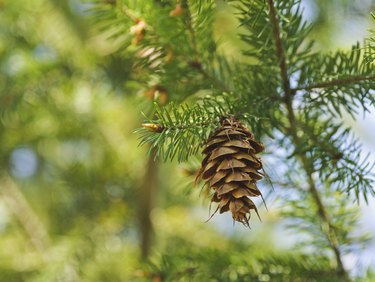
Do all evergreen trees look the same to you? While fir and pine trees might look similar, these evergreen trees have subtle differences, including their botanical name, native ranges, and cone shape. Foliage characteristics are the best way to differentiate the two, with differences in needle clusters and lengths often giving clues to the type of tree you're seeing.
Tip
Pine trees and fir trees are both evergreens with needles and cones, but they have subtle differences in how and where they grow.
Video of the Day
Tree Botanical Classification
Although both fir and pine trees are conifers, bearing cones, and members of the same plant family, Pinaceae, their plant group names are different. Fir trees are members of the genus Abies; whereas pine trees belong to Pinus. Some of the differences between firs and pines are reasons why these two conifers are given different classification.
Video of the Day
Native Growing Areas
Fir species number about 50, all native to very cold or mountainous regions in the Northern Hemisphere, and grow best in similar climates. They are regarded as trees.
Pine species are much more numerous, with about 120 species, and are native to many forest types in the Northern Hemisphere, from cold regions to the subtropics. Pines can be trees or shrubs.
Tree Foliage Characteristics
Taking a closer look at the needles can usually help you distinguish between pine trees and fir trees. Fir trees have relatively short needles, almost always less than 2 inches in length, and occur singly on the stem in great numbers. The needle is soft to the touch, flattened with two sides, usually with two white stripes on each needle's underside. The tip of the needle has a notch.
Pine trees have needles that are in clusters, from two to eight needles per cluster, very rarely only one per bundle. The needles are glossy, soft, thin, and thread-like, with a length from just less than 1 inch to as long as 12 to 16 inches, depending on species.
Tree Form and Bark
Firs grow with a consistently tall, upright triangular form. This creates a classic pointed tree that's wider at the bottom near the lower branches. Bark, often hidden by the branches and needles, is smooth but corky.
Pine trees are also upright, but they have more of an open, rounded canopy of foliage. They're sometimes loosely triangular but irregular, or they can look like a jagged lollipop at maturity. Bark is usually cracked with plate-like scales with a darker color under them.
Cones Produced by Trees
Both types of evergreen trees produce cones, but they have different features. Fertile, female fir cones are produced only on the uppermost branches, are held upright, and are shaped liked eggs. They are purplish blue-green in color, ripening to a golden medium brown at the end of the growing season. Male cones are pendent and occur all over the tree in late spring. They fall off after they release their pollen.
Seed-producing female pine cones are seen at branch tips and point downward or horizontally. First green, they become reddish brown to black, splitting open to release winged seeds. The female cone takes two to three years to fully ripen and open on the tree. Male pine cones are small and appear at the base of needle clusters. They shed their yellow pollen in spring before falling away.